Endangered Animals - The Hippopotamus
The word 'hippopotamus' is made up of two Greek words. 'Hippos' means 'horse' and 'potamus' means 'river'. The hippopotamus is not related to the horse however, but has more in common with pigs, whales and dolphins. They are herbivorous and amphibious. A group of hippos is called a 'bloat' which might account for their bad temper! They live in and around the edges of slow-moving rivers and lakes.
Hippos are well adapted for living in water. When their body is in water, the eyes, ears and nostrils are on the top of the head and they can see, hear and breathe without any trouble. The capybara, a South American rodent which spends a lot of time in water, also has its ears, eyes and nostrils on the top of the head. When the hippo goes beneath the surface, a clear membrane covers the eyes allowing them to see underwater. They have muscles which keep their nostrils clamped shut and the ears press down flat against the head. The heart rate slows down considerably.
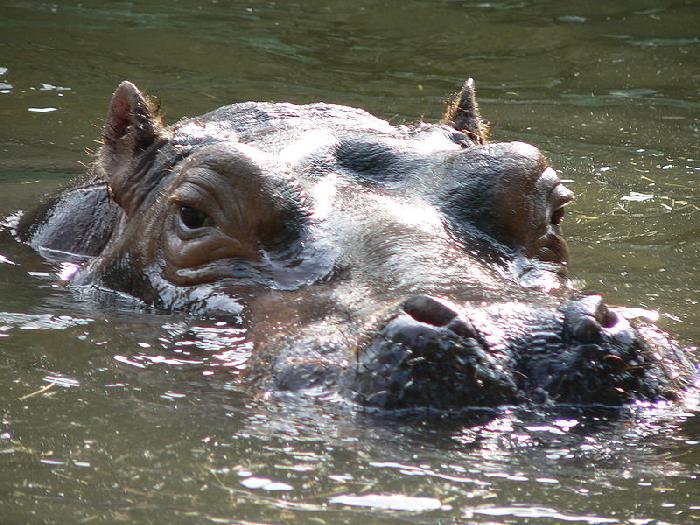
Adults can stay under water for 30 minutes if they have to but normally come to the surface to breathe every 6 to 7 minutes. Newborn calves can stay under for about 30 seconds. Hippos are far too dense to float and apparently they don't know how to swim! Instead they push themselves off the bottom of the river and walk or run along the river bed.
The River or Common Hippopotamus
There are two species the river or common hippo and the pygmy hippo.
In Africa, the river or common hippo (Hippopotamus amphibious) is sometimes stated as being responsible for more human deaths than any other large animal. Certainly the hippopotamus, cape buffalo and crocodile are the three most dangerous animals. Like the wedge-tail eagle, the hippo has no natural predators. Hippos need no provocation to attack and are unpredictable, extremely aggressive and unafraid. There have been instances where a hippo seems to move to deeper water if he is given warning of an approaching craft but generally they upset boats with no qualms at all. If a hippo is startled or something gets in its path, attack is almost inevitable.
The toes on the river hippo's foot are webbed and spread evenly. This helps distribute their massive weight.
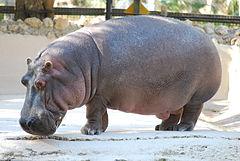
The grey skin is thin and has almost no hair. A subcutaneous a layer of fat helps keep the animal warm when it is in the water. The skin must be kept wet for most of the day. The hippo doesn't have sweat or sebaceous (fatty) glands. If a hippo is out of the water for too long, it will dehydrate. Water and/or mud keep it cool. A viscous red fluid called 'blood sweat' is secreted and forms a mucous layer which acts as sunscreen and is also thought to be a healing agent. They frequently have quite large wounds but rarely do these wounds get infected.
Defecation occurs in the water (and everywhere else!) and the manure is spread by the animal's flat, paddle-like tail. This marks their territory and also indicates the status of the individual.
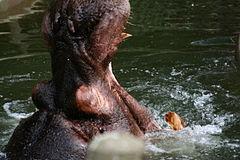
Rival bulls will approach each and yawn or 'gape' at each other. Their mouths can open up to 150 degrees. The smaller bull will normally retreat. Rearing up, lunging, grunting, roaring and head-shaking are all threat behaviours. Hippos fight by slashing at each other with their tusks and using their heads like giant sledge-hammers. Fights are accompanied by non-stop bellowing. These battles are very aggressive and can end in the death of the weaker opponent.
Due to the reduction of its habitat, the status of the hippo is now regarded as 'vulnerable'. The river hippo was once found from the Nile delta to the Cape but is now found only in East Africa south of the Sahara and then mostly in protected areas. The hippo is easily controlled by low ditches or fences but hundreds are still shot each year in dubious schemes which are purported to be for 'controlled management'. The hippo is popular for its meat. The tusks are more easily carved than elephant ivory and the horn is supposedly an aphrodisiac. They graze on land which is suitable for farming so are not popular with farmers.
The hide of the hippo can weigh 500kg. Only the elephant and white rhino are larger. Bulls are very territorial. Both sexes have a very short fuse and are easily enraged. The canine teeth may be 51cm in length and grow continually.
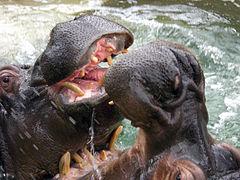
The social system of the 'bloat' is quite flexible, governed by the availability of food and water and hierarchy. Generally mixed bloats of 15 or more are led by a dominant bull but sometimes he will allow subordinate bulls to trespass and even mate with the cows of his group. During periods of drought there in increased aggression and fighting as overcrowding occurs near any available water.
Calves are born during the wettest time of the year. The cow goes off on her own to give birth and to bond with her calf. The gestation period is about eight months and the calf is born on land or in shallow water. If born underwater, the mother pushes the calf to the surface. Calves weigh only 25 to 50kg and are protected with great concern by the mother. The main dangers to the calf are crocodiles, lions and male hippos.
Young hippos suckle by taking a deep breath, closing the ears and nostrils and wrapping the tongue tightly round the teat. This happens whether on land or in water. In the water, youngsters take a rest by climbing on the back of the mother or by resting their heads on her back. Young hippos play together and may be left with other females while the cow goes off to feed. By three weeks of age, the calf is beginning to sample grass but it will continue to suckle for about a year.
Although hippos cannot jump, they are very agile and often climb quite steep banks to reach grazing areas. They can travel at 30kph but only for short distances. Despite their bulk, they consume only about 1 to 1 % of their body weight (40 odd kilograms). Bulls weigh around 3 tonnes and cows about half that. They feed at night. For preference, they'll stay close to water but will travel several kilometres if necessary to reach new grazing. They conserve energy by not engaging in unnecessary activity. Feeding takes place at night and they doze in or near water for the rest of the day.
The Pygmy Hippopotamus
The Pygmy Hippo (Hexaprotodon liberiensis or Choeropsis liberiensis) is much smaller (158 to 274 pounds), and less than 1 metre high at the shoulder. They face increasing pressure from heavy clearing of forest areas. At the moment they are found in rivers and swamps in the tropical rainforests of western Africa. The pygmy hippo is related to the river hippo, the giraffe and the warthog. It lives alone or in pairs and is more pig-like than the river hippo.
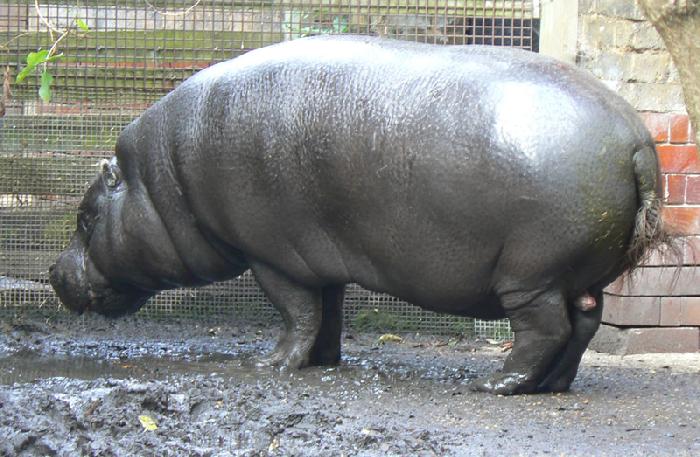
The shape is the same but the legs are relatively longer, the head is smaller, rounder and narrower, the eyes are less prominent and the ears and eyes are more on the side of the head. It was once thought to be a dwarf or mutation but has now been proven to be a separate species. Like its big cousin, it 'sweats blood'. This gives a glossy sheen to the skin which is devoid of hair, smooth and black/brown to purple in colour. There is often a pink tint to the cheeks and the end of the stubby tail is adorned with a wiry yellow tassel of hair. There is virtually no webbing between the toes.
It leads a very lazy life, resting up during the day and feeding by the water at night. They have a number of moist or wet areas which are used exclusively for sleeping. Each individual has a home range. The cow has 100 to 150 acres and the males about 400 acres. There is extensive overlapping but, probably due to leaving dung markings, they actively keep out of each other's way. Tracks and tunnels are used through their areas. Pygmy hippos will flee and hide when threatened.
Gestation takes about six months. Calves weigh 4.5 to 6.2kg and may be hidden in vegetation until strong enough to follow the mother. She will return to feed the calf from time to time. At three months it will begin to eat plant material and will be weaned at 6 to 8 months. It will be encouraged to leave home at two years old and by four or five it will be sexually mature. The lifespan in captivity is about thirty years. The main predator of the pygmy hippopotamus is the leopard.
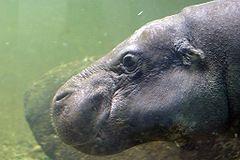
At Singapore Zoo, there is a glass viewing window and the resident pygmy hippo can be seen 'swimming'. The action is much like that of an astronaut walking on the moon. With great grace and apparent buoyancy, the hippo pushes off the bottom with one foot, has a period of suspension then pushes off with the next foot.
- True Stories Of Interspecies Animal Friendships
By Julia Williams There are so many things about animals I love that it would be hard to pick just one thing I admire most. But when I see examples of unlikely animal friendships, particularly those of two natural born enemies, it really touches my heart....
- Interesting Facts About The Gigantic Giraffe
Giraffes are among the most fascinating animals on the planet due to their very tall appearance and unique markings which make them among the most well-known animals in the world.Here’s a long list of interesting and amazing facts about one of the...
- One Of A Kind - The Walrus
Monotypic Species - Keystone Species - The Walrus Is BothThe walrus is a monotypic species as it is the only living species in the genus Odobenus. There are a number of animals that are the sole representatives of their particular genera. Some of these...
- Animals A To Z
This list of animals is great for when you want to teach your children about all the different animals of the world. From A to Z you can learn the different animals names and a few facts about them. Aardvark: Aardvarks are from Africa and are known...
- One Of A Kind - The Giraffe
The Giraffe - An Example of a Monotypic GenusThe giraffe (Giraffa camelopardalis) belongs to the family, Giraffidae, and the genus Giraffa. 'Camelopard' is an archaic English name for the giraffe referring to its camel-like face and leopard-like...
